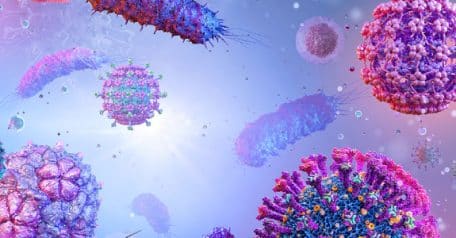The Takeaway: While many studies now back up the initial hypothesis that SARS-CoV-2 would behave as a zoonotic virus, analysis of biological samples from multiple animal species indicate the overall impact to Fido is low.
Since the start of the SARS-CoV-2 pandemic, the connection between animals and humans has been a prevalent part of our conversations. Today, it’s widely known that officials in Wuhan, China found evidence of viral transmission in a horseshoe bat, leaving many scientists seemingly in agreement on the classification of COVID-19 as a zoonotic virus.
What is a zoonotic virus? A zoonotic virus lives naturally in an animal and can infect human cells, perhaps mutating slightly during passage, which enables the virus to start a chain of infection through human hosts. Does this sound like the plot of a sci-fi movie? It’s more common than you’d think.
The Center for Disease Control estimates that six out of every 10 known infectious diseases in people start in animals
"Viruses are as variable as other forms of life and take lots of strategies to survive and pass along genetic material,” Dr. Don Neiffer, Chief Veterinarian at the Smithsonian National Zoo, noted during an interview with the Smithsonian Science Education Center. “Some viruses have evolved in humans and others in animal species. Primates (including humans), bats, and rodents are much more related genetically than many people realize. Consequently, it is not surprising that viruses carried in bats and rodents can take advantage of our cells and DNA/RNA and cause problems."
Yet, while zoonosis is common, the likelihood of significant impact to humans is low. There are only a few documented viruses known to cause increased immune response in humans. Some examples of other known zoonotic viruses include Ebola, Influenza, Rabies, and the Zika virus. The SARS family of viruses is, of course, also one of these.
In early 2020, the first case of SARS-CoV-2 transmission to a zoo animal was recorded when a tiger at the Bronx Zoo tested positive. Around the same time, several gorillas at the San Diego Zoo Safari Park in California tested positive, marking the first case of natural transmission in great apes.
Analysis of fecal samples indicated both the tiger and gorillas likely contracted the virus from their human keepers.
If zoo animals are at risk for COVID-19, are our pets, too? The short answer: yes; but it depends on the animal species.
Domesticated pets can contract the same viral strains as humans
If our pets can contract SARS-CoV-2, does this mean they can also experience the same severity of illness as we’ve seen in humans around the globe? The answer to this question depends on the animal species.
Also in early 2020, instances of severe acute respiratory distress signaled possible infections in dogs in both the U.S. and Hong Kong. After analyzing nasal swabs taken from a 17-year-old Pomeranian and a 2.5-year-old German Shepherd, researchers learned the same viral SARS-CoV-2 strains were present as those found in humans.
Outbreaks in The Netherlands and Denmark noted human-to-mink transmissions. In the early months of 2020, 68% of mink farmers tested positive for SARS-CoV-2 virus or antibodies, leading to the ultimate closure of all mink farms in those two countries in June 2021.
In these cases, much like those from the zoos, the animals remained either asymptomatic or mildly symptomatic.
SARS-CoV-2-infected cats suffered from more severe symptoms
A research team in Italy tested 900 pets and found nearly 6% of those living in SARS-CoV-2 households carried the antibodies, indicating prior presence of the virus. Unlike the other animal species, the cats suffered from upper respiratory symptoms, frequent sneezing, long-lasting olfactory disorders, and joint stiffness.
Curious to determine why some symptoms remained consistent across species while others did not, scientists applied next generation sequencing to review whole genomes of the human and feline strains. The results showed 99.9% similarities between the two strains.
Despite transmission, cats function at a lower rate of viral replication, meaning the severity of the virus is lower than in their human owners. Canines, however, are unable to replicate the virus. This genetic difference is believed to be the explanation of why the cats in Italy and other felines in zoos presented COVID-19 symptoms, whereas other animals and domesticated pets did not.
Should I be concerned about my pet getting COVID-19?
Only a little. Until more studies are conducted, scientists and veterinarians recommend using good hygiene practices when caring for pets living in households where SARS-CoV-2 was present. When ill, if possible, consider asking a friend or family member to care for your pets so you can social distance and limit exposure to them. This measure is intended to protect the well-being of pets but does not stem from a public health concern.
Here is something that may help you rest easy: of the pets who tested positive for SARS-CoV-2 and were symptomatic, blood and bioanalysis performed six months later showed no permanent signs of damage. The infected household animals made a full return to health and normalcy.

























